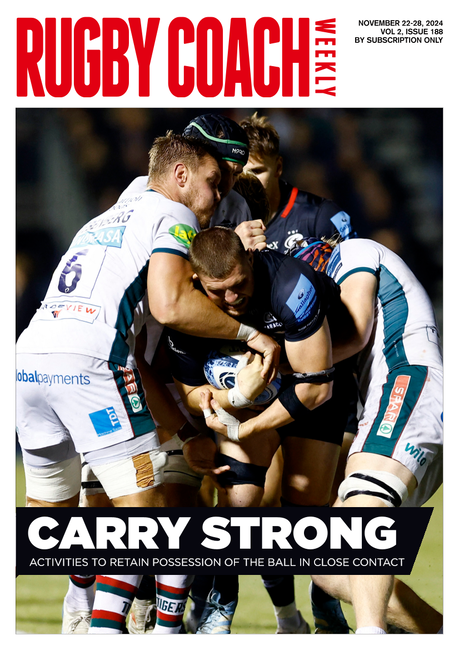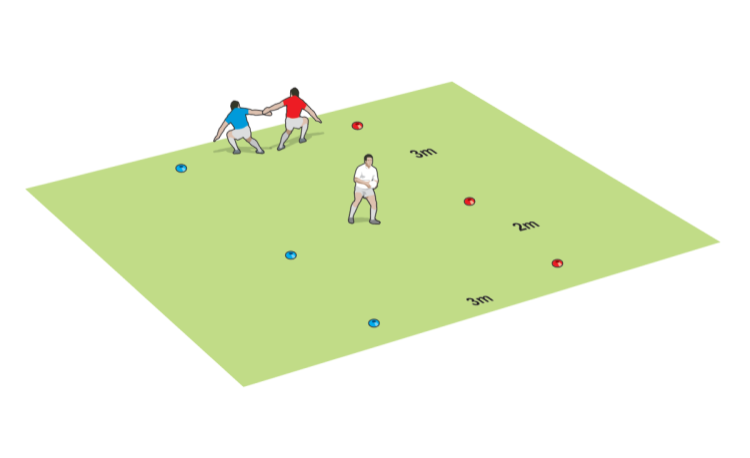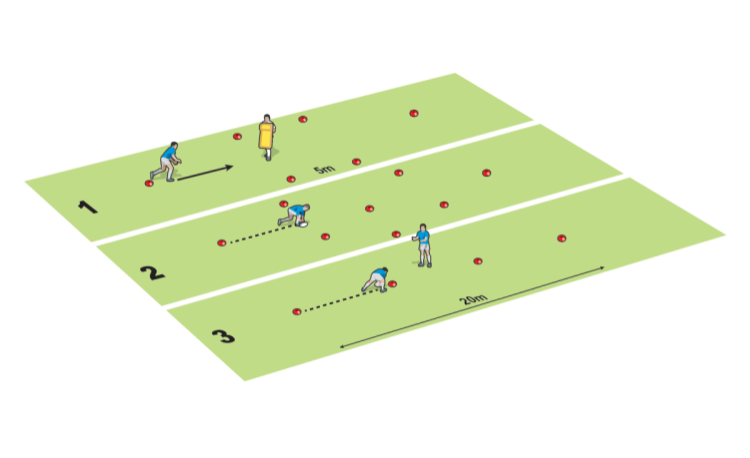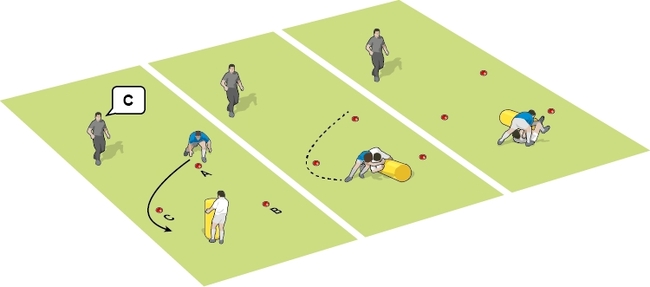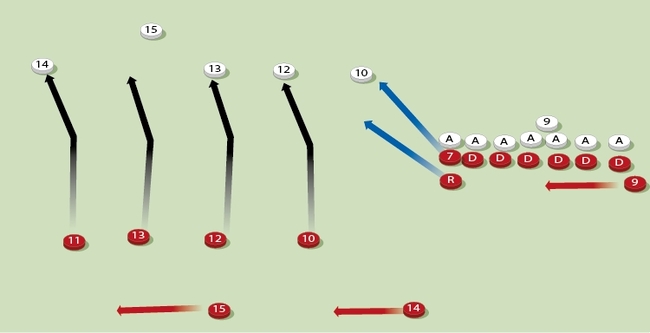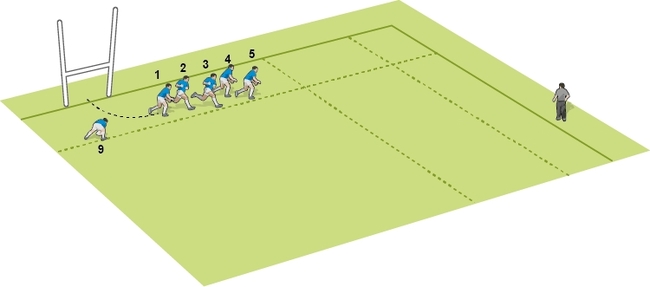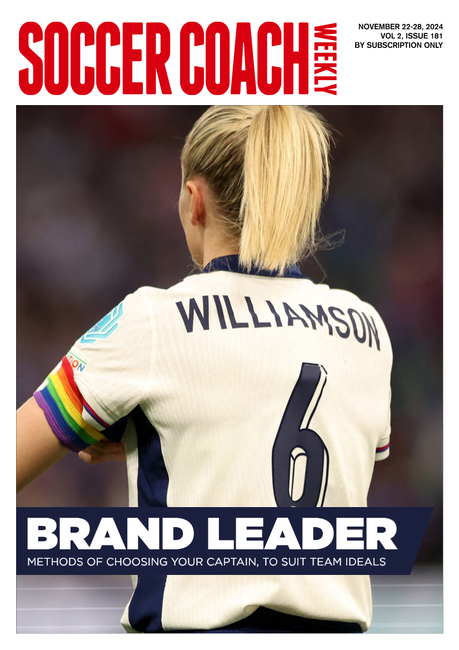Match intensity for good habits
Drillsby Eamonn Hogan
Practising like you want to play is a good way to prepare for matches. However, you need to make sure you get the balance right so that skills are not compromised in the pursuit of intensity.
Rucking practice: In a given time, forwards have to recycle ball and clear out accurately

Overlap practice: Attackers draw defenders and see how many scores they can register in their given time

Ask players what they enjoy most about training and more than likely they will say they love games so long as they are competitive. Games are the most fun and this is the same for any age group.
However, when trying to reinforce or introduce key points within an aspect of our game, we sometimes need to use drills to ensure players grow into the correct habits and develop a knowledge of exactly what we are asking them to do.
So because you need to do “drills”, you have to ensure they are motivational by making sure they are
One misconception about intensity during drills is that they need to be done at 100 miles an hour. This is not always the case. Take a snippet or situation from a match then strip it right back down to the basics. Build it all the way back with limits or key areas of focus. This is where lots of learning happens.
As a starting point for intensity, I set players time limits to get things done - this also adds to the realism.
During my sessions, I tend to use timed practices a lot. For example, for decision making, we will work on the principle of the 3v2 and our roles as attackers in it. Once we have grasped it we then see how many 3v2s we can execute in two or three minutes. I find setting the time tests players and focuses them on performing skill/ drill under pressure.
Forwards can set up a rucking practice involving three sets of two ruck pads behind one another. A group of four (ball carrier plus three) take the ball into contact then clear out the first two pad holders and then move on to the next pair (see picture 1 above).
This could be used to time how quickly they recycle ball and could also be used as a conditioning drill so the group has to see how many rucks it can clear accurately under pressure in a minute.
Backs can use a 3v2 overlap drill in a 10m square. This is carried out between the 5m and 15m lines with lines of three attackers at each end of the box and two defenders in the middle (see picture 2 above).
The attackers draw the defenders, create an overlap then pass on to the next group. From this you could see how many scores you can create in two minutes or which team of three scores the most tries.
Rucking practice: In a given time, forwards have to recycle ball and clear out accurately

Overlap practice: Attackers draw defenders and see how many scores they can register in their given time

Ask players what they enjoy most about training and more than likely they will say they love games so long as they are competitive. Games are the most fun and this is the same for any age group.
However, when trying to reinforce or introduce key points within an aspect of our game, we sometimes need to use drills to ensure players grow into the correct habits and develop a knowledge of exactly what we are asking them to do.
So because you need to do “drills”, you have to ensure they are motivational by making sure they are
- Match related
- Intense
One misconception about intensity during drills is that they need to be done at 100 miles an hour. This is not always the case. Take a snippet or situation from a match then strip it right back down to the basics. Build it all the way back with limits or key areas of focus. This is where lots of learning happens.
As a starting point for intensity, I set players time limits to get things done - this also adds to the realism.
Time in the drill
During my sessions, I tend to use timed practices a lot. For example, for decision making, we will work on the principle of the 3v2 and our roles as attackers in it. Once we have grasped it we then see how many 3v2s we can execute in two or three minutes. I find setting the time tests players and focuses them on performing skill/ drill under pressure.
Unit-related practices
Forwards can set up a rucking practice involving three sets of two ruck pads behind one another. A group of four (ball carrier plus three) take the ball into contact then clear out the first two pad holders and then move on to the next pair (see picture 1 above).
This could be used to time how quickly they recycle ball and could also be used as a conditioning drill so the group has to see how many rucks it can clear accurately under pressure in a minute.
Backs can use a 3v2 overlap drill in a 10m square. This is carried out between the 5m and 15m lines with lines of three attackers at each end of the box and two defenders in the middle (see picture 2 above).
The attackers draw the defenders, create an overlap then pass on to the next group. From this you could see how many scores you can create in two minutes or which team of three scores the most tries.
Related Files
Vol-1-Issue-512-G-Blackburn-match-intensity-for-good-habits.pdfPDF, 544 KB
Newsletter Sign Up
Coaches Testimonials

Gerald Kearney, Downtown Las Vegas Soccer Club

Paul Butler, Florida, USA

Rick Shields, Springboro, USA

Tony Green, Pierrefonds Titans, Quebec, Canada
Subscribe Today
Be a more effective, more successful rugby coach
In a recent survey 89% of subscribers said Rugby Coach Weekly makes them more confident, 91% said Rugby Coach Weekly makes them a more effective coach and 93% said Rugby Coach Weekly makes them more inspired.
Get Weekly Inspiration
All the latest techniques and approaches
Rugby Coach Weekly offers proven and easy to use rugby drills, coaching sessions, practice plans, small-sided games, warm-ups, training tips and advice.
We've been at the cutting edge of rugby coaching since we launched in 2005, creating resources for the grassroots youth coach, following best practice from around the world and insights from the professional game.


